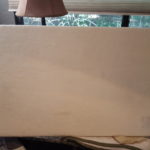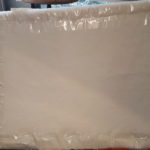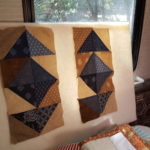My quilting work has been “freeform” lately. I have been studying books that promote this spontaneous way of abstraction. In freeform quilting, I piece together random fabrics, add more fabric, cut, and insert strips. When all those pieces go into a larger whole, it helps to first observe different squares on a design board. It is much easier to see how things look together when you can see head on, rather than by spreading it out on a flat surface.

Portable design board, $139
This design wall, which hangs on a large wall, costs $40.00
As you can see, the thick, store-bought design walls are expensive. I do not have a large wall where I can permanently hang flannel. No problem! In one of my new books, I learned how to make a smaller, portable design board for peanuts.
Supplies
- Foam core board from craft store (it is the size of poster board, usually). I bought a faux foam core board at the Dollar Store ($1)
- Batting or flannel to cover the board
- Clear tape
That is it! I wrapped some batting that I had already and tapped it to the board using clear box tape. You could use any tape, but I liked the neat look!

Poster board sized craft board, covered with quilt batting

Back side of design board, shows clear tape

Design board, in front of the window, with two quilt panels. These are not freeform panels like I talked about in the text.
